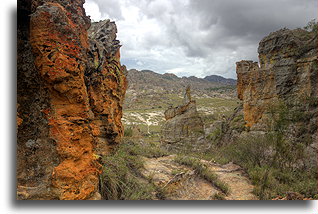Bara
January 12-13
Ideal would be to drive from Tulear straight north to Morondava and from there back to Antananarivo, Madagascars capital city also known in short as Tana. I know that such journey is possible, but unfortunately not in January. Not everywhere along the way are bridges over the rivers and during the rainy season river water levels are too high for crossing. Having no other choice, we had to turn around and go exactly the same way you came from Tana.




We retraced our steps and stayed again in Le Jardin du Roy, beautifully located hotel. The following day we went to Isalo National Park. Near the park office, exact same guide was waiting for potential tourists. He was happy to see us again because there is not too much work for guides at that time. He took us to a different part of the park. In that area Isalo resembles North Americas West like Utahs Capitol Reef or some parts of Canyonlands. Similarity comes from the analogous geological origin of these landscapes. Millions of years ago, both areas were flooded with the warm waters of the inland sea. As a result, sandstone, shale, and limestone were deposited there. Erosion did the rest. This is why many marine origin fossils can be found here.



After a short climb up, we reached the main plateau in Isalo. There was a beautiful view behind, but our guide pointed to rock pile nearby. This is Bara tribe country-he said. They do not live within the park anymore, but they are still allowed to follow their old funeral tradition here, this is a sacred site for them. So, it must be a grave-I heard Matt behind me. Yes a grave, but only temporary one- was the answer. It turned out that according to the tradition, Bara people prepare resting place for their dead inside a pile of stones. After four, sometimes five years family opens the grave and removes bones. The big celebration is expected in the village, the ritual of cleaning bones if performed. Relatives transfer washed, loose bones to the mountain cave and hide them neatly inside. They seal the grotto entrance with rocks. This is to protect permanent tomb and human remains from thieves and animals.





We have heard about Bara before. This ethic group has been often mentioned in our conversations with other Malagasy people. Is it true that a cattle raiding is still one of the most important elements in Bara culture? -was the question I had to ask. Yes, young Bara men steal Zebu cattle and go to jail for doing that. That shows their masculinity. Only a strong man can have many wives-our guide expressed that with a gesture of clenched fist and added-weak man that does not steal zebu has no respect from women. Without any doubt that long outlawed practice is still alive. Without hesitation, Eva followed with the question, did you say one man can marry many wives?




Originated from Africa, Bara is Malagasy ethnic group, which still lives a semi-nomadic lifestyle. They live in small villages consisting of primitive rectangular earthen houses. Men often walk with spears in their hands as a weapon to protect their herds of cattle, which in turn are extremely important in their culture. Bara mostly are not Christians and still practice the old traditional beliefs. There is nothing to stop them from having several wives. Based on what we have heard, Bara families often have three or four women living with one man.









